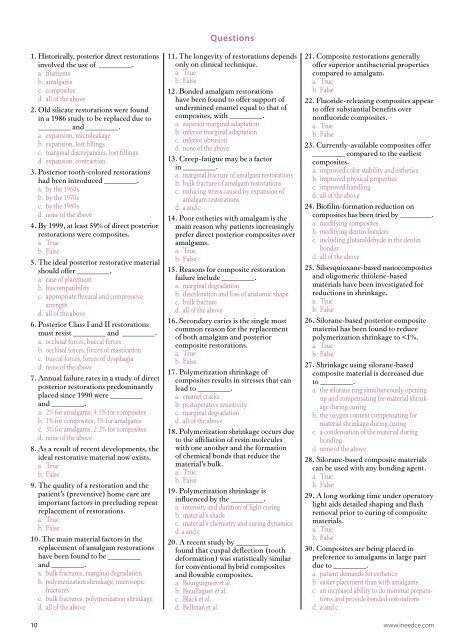The Properties and Selection of Posterior Direct ... - IneedCE.com
The Properties and Selection of Posterior Direct ... - IneedCE.com
The Properties and Selection of Posterior Direct ... - IneedCE.com
You also want an ePaper? Increase the reach of your titles
YUMPU automatically turns print PDFs into web optimized ePapers that Google loves.
1. Historically, posterior direct restorations<br />
involved the use <strong>of</strong> _________.<br />
a. filaments<br />
b. amalgams<br />
c. <strong>com</strong>posites<br />
d. all <strong>of</strong> the above<br />
2. Old silicate restorations were found<br />
in a 1986 study to be replaced due to<br />
_________ <strong>and</strong> _________.<br />
a. expansion, microleakage<br />
b. expansion, lost fillings<br />
c. marginal discrepancies, lost fillings<br />
d. expansion, contraction<br />
3. <strong>Posterior</strong> tooth-colored restorations<br />
had been introduced _________.<br />
a. by the 1960s<br />
b. by the 1970s<br />
c. by the 1980s<br />
d. none <strong>of</strong> the above<br />
4. By 1999, at least 59% <strong>of</strong> direct posterior<br />
restorations were <strong>com</strong>posites.<br />
a. True<br />
b. False<br />
5. <strong>The</strong> ideal posterior restorative material<br />
should <strong>of</strong>fer _________.<br />
a. ease <strong>of</strong> placement<br />
b. bio<strong>com</strong>patibility<br />
c. appropriate flexural <strong>and</strong> <strong>com</strong>pressive<br />
strength<br />
d. all <strong>of</strong> the above<br />
6. <strong>Posterior</strong> Class I <strong>and</strong> II restorations<br />
must resist _________ <strong>and</strong> _________.<br />
a. occlusal forces, buccal forces<br />
b. occlusal forces, forces <strong>of</strong> mastication<br />
c. buccal forces, forces <strong>of</strong> dysphagia<br />
d. none <strong>of</strong> the above<br />
7. Annual failure rates in a study <strong>of</strong> direct<br />
posterior restorations predominantly<br />
placed since 1990 were _________<br />
<strong>and</strong> _________.<br />
a. 2% for amalgams, 4.5% for <strong>com</strong>posites<br />
b. 1% for <strong>com</strong>posites, 3% for amalgams<br />
c. 3% for amalgams, 2.2% for <strong>com</strong>posites<br />
d. none <strong>of</strong> the above<br />
8. As a result <strong>of</strong> recent developments, the<br />
ideal restorative material now exists.<br />
a. True<br />
b. False<br />
9. <strong>The</strong> quality <strong>of</strong> a restoration <strong>and</strong> the<br />
patient’s (preventive) home care are<br />
important factors in precluding repeat<br />
replacement <strong>of</strong> restorations.<br />
a. True<br />
b. False<br />
10. <strong>The</strong> main material factors in the<br />
replacement <strong>of</strong> amalgam restorations<br />
have been found to be _________<br />
<strong>and</strong> _________.<br />
a. bulk fractures, marginal degradation<br />
b. polymerization shrinkage, microsopic<br />
fractures<br />
c. bulk fractures, polymerization shrinkage<br />
d. all <strong>of</strong> the above<br />
Questions<br />
11. <strong>The</strong> longevity <strong>of</strong> restorations depends<br />
only on clinical technique.<br />
a. True<br />
b. False<br />
12. Bonded amalgam restorations<br />
have been found to <strong>of</strong>fer support <strong>of</strong><br />
undermined enamel equal to that <strong>of</strong><br />
<strong>com</strong>posites, with _________.<br />
a. superior marginal adaptation<br />
b. inferior marginal adaptation<br />
c. inferior obtusion<br />
d. none <strong>of</strong> the above<br />
13. Creep-fatigue may be a factor<br />
in _________.<br />
a. marginal fracture <strong>of</strong> amalgam restorations<br />
b. bulk fracture <strong>of</strong> amalgam restorations<br />
c. reducing stress caused by expansion <strong>of</strong><br />
amalgam restorations<br />
d. a <strong>and</strong> c<br />
14. Poor esthetics with amalgam is the<br />
main reason why patients increasingly<br />
prefer direct posterior <strong>com</strong>posites over<br />
amalgams.<br />
a. True<br />
b. False<br />
15. Reasons for <strong>com</strong>posite restoration<br />
failure include _________.<br />
a. marginal degradation<br />
b. discoloration <strong>and</strong> loss <strong>of</strong> anatomic shape<br />
c. bulk fracture<br />
d. all <strong>of</strong> the above<br />
16. Secondary caries is the single most<br />
<strong>com</strong>mon reason for the replacement<br />
<strong>of</strong> both amalgam <strong>and</strong> posterior<br />
<strong>com</strong>posite restorations.<br />
a. True<br />
b. False<br />
17. Polymerization shrinkage <strong>of</strong><br />
<strong>com</strong>posites results in stresses that can<br />
lead to _________.<br />
a. enamel cracks<br />
b. postoperative sensitivity<br />
c. marginal degradation<br />
d. all <strong>of</strong> the above<br />
18. Polymerization shrinkage occurs due<br />
to the affiliation <strong>of</strong> resin molecules<br />
with one another <strong>and</strong> the formation<br />
<strong>of</strong> chemical bonds that reduce the<br />
material’s bulk.<br />
a. True<br />
b. False<br />
19. Polymerization shrinkage is<br />
influenced by the _________.<br />
a. intensity <strong>and</strong> duration <strong>of</strong> light curing<br />
b. material’s shade<br />
c. material’s chemistry <strong>and</strong> curing dynamics<br />
d. a <strong>and</strong> c<br />
20. A recent study by _________<br />
found that cuspal deflection (tooth<br />
deformation) was statistically similar<br />
for conventional hybrid <strong>com</strong>posites<br />
<strong>and</strong> flowable <strong>com</strong>posites.<br />
a. Bourguignon et al.<br />
b. Bouillaguet et al.<br />
c. Black et al.<br />
d. Bellman et al.<br />
21. Composite restorations generally<br />
<strong>of</strong>fer superior antibacterial properties<br />
<strong>com</strong>pared to amalgam.<br />
a. True<br />
b. False<br />
22. Fluoride-releasing <strong>com</strong>posites appear<br />
to <strong>of</strong>fer substantial benefits over<br />
nonfluoride <strong>com</strong>posites.<br />
a. True<br />
b. False<br />
23. Currently-available <strong>com</strong>posites <strong>of</strong>fer<br />
_________ <strong>com</strong>pared to the earliest<br />
<strong>com</strong>posites.<br />
a. improved color stability <strong>and</strong> esthetics<br />
b. improved physical properties<br />
c. improved h<strong>and</strong>ling<br />
d. all <strong>of</strong> the above<br />
24. Bi<strong>of</strong>ilm-formation reduction on<br />
<strong>com</strong>posites has been tried by _________.<br />
a. modifying <strong>com</strong>posites<br />
b. modifying dentin bonders<br />
c. including glutaraldehyde in the dentin<br />
bonder<br />
d. all <strong>of</strong> the above<br />
25. Silsesquioxane-based nano<strong>com</strong>posites<br />
<strong>and</strong> oligomeric thiolene-based<br />
materials have been investigated for<br />
reductions in shrinkage.<br />
a. True<br />
b. False<br />
26. Silorane-based posterior <strong>com</strong>posite<br />
material has been found to reduce<br />
polymerization shrinkage to
















